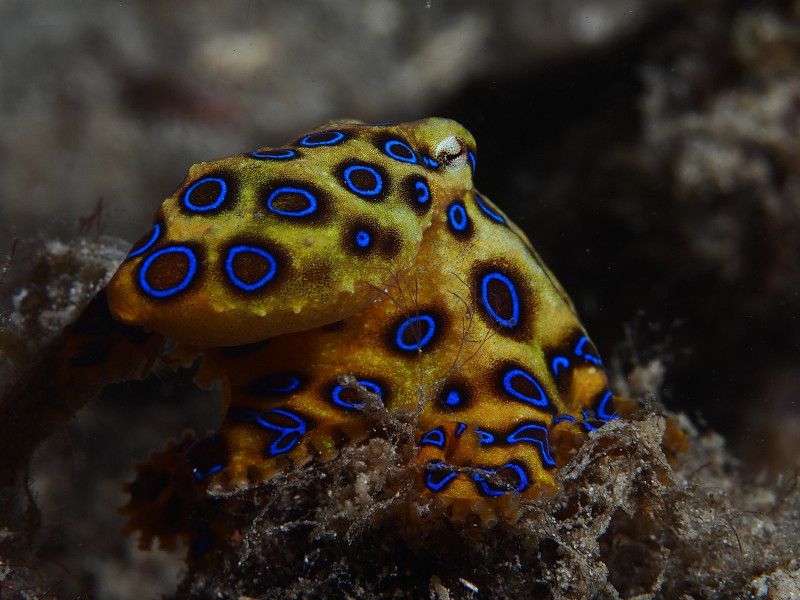
Greater blue-ringed octopus Facts
- This gorgeously-hued creation of Nature and evolution most frequently goes by the descriptive common name of the Greater blue-ringed octopus. For the moment, the cephalopod has no other generally accepted non-technical name by which it’s known.
- Professionals, such as researchers, meanwhile, most often refer to the animal by its formal scientific name. That term, though, represents a true tongue-twister. That’s because the amazing animal bears the official name of the Hapalochlaena lunulata.
- Regardless of the term one chooses to use to refer to it, however, it’s a fascinating species. That’s partly due to the fact that it also represents one of only four known species of blue-ringed octopuses. Among those, it further ranks as one of the smallest.
- The first official recognition of the animal as a separate and distinct species further took place in the year 1832. At that time, the French researchers Jean Rene Constant Quoy and Joseph Paul Gaimard made the original notation in the annals of science.
- For the moment, at least, the Greater blue-ringed octopus appears to be maintaining a population base that’s both stable and sufficient. This also seems to hold true throughout the entirety of its range. The IUCN, therefore, lists it as Least Concern.
- The cephalopod nevertheless faces some potential threats to its existence, like many species. Potential habitat degradation remains a possible threat. Its greatest danger, however, most likely comes from the peril posed by ongoing climate change.
Related Articles
Greater blue-ringed octopus Physical Description
The breathtaking Greater blue-ringed octopus easily draws the eye of all who encounter it. The intriguing animal does not do so, however, due to sheer size. That’s due to the fact that, all other impressive statistics aside, it actually remains extremely small in size.
Unlike many related creatures, it does not display any noticeable degree of the physiological characteristic of sexual dimorphism, however. Both genders therefore manifest the same small size. Individuals rarely exceed 3.9 in (10 cm) in length, arms included!
The common name, in fact, actually refers to the distinctive markings, blue rings, similar to members of all four related species. In its specific case, though, these develop as larger than any of the other members of the group. Its colorful rings average 0.3 in (0.8 cm).
These also display the namesake bright blue color. Each of the rings further appears spread equally across all parts of the body and tentacles. In most individuals, these dazzling blue formations number approximately 60. Each is also surrounded by a thin black rim.
Each individual Greater blue-ringed octopus, like its numerous brethren, changes colors frequently, with random patterns. Some colors predominate, however. In the case of this species, these several colors include dark yellow, light brown, and even off-white.
- Kingdom: Animalia
- Phylum: Mollusca
- Class: Cephalopoda
- Order: Octopoda
- Family: Octopodidae
- Genus: Hapalochlaena
- Species: H. lunalata
Greater blue-ringed octopus Distribution, Habitat, and Ecology
Fortunately, both for the Greater blue-ringed octopus itself, and those of us who appreciate Nature, it has a relatively wide range of distribution. That’s due to the fact that its habitat range appears to cover most of the western portion of the Indo-Pacific Ocean.
That includes the area from Sri Lanka to the Phillipines in one section. In another portion of the range, it appears from Australia to Papua New Guinea. Individuals also seem to live as far as the Solomon Island and Vanuatu. Populations of the animal also appear throughout.
In all areas where it appears, though, it displays decidedly strong preferences for its choice of habitat. The creature appears almost exclusively in regions of very shallow waters, up to the shoreline. It also clearly prefers a mixed base, including reefs, sand, and stones.
Again mimicking most of its relatives, it typically lives in a burrow. Most spend the majority of their time there, only coming out to feed or to mate. The remains of previous meals often line the outside of the burrow, making the animal’s dweling easily recognizeable.
In keeping with its nature, the stunning Greater blue-ringed octopus feeds entirely carnivorously. Given its size, though, it sticks to small prey. These most commonly consist of such creatures as shrimp and crabs. It does occasionally, however, feed on small fish.
Fortunately for humans, this animal evolved as a generally calm, docile one. It rarely attacks unless handled or directly threated, such as simply stepping on it near the shoreline. It’s bite’s actually one of the most poisonous of all marine creatures, often fatal.
Species Sharing Its Range
Check out our other articles on 5 Amazing Andean Species, Snowy Owl, Lake Hillier, Platypus, Gray’s Leaf Insect, Satanic Leaf-Tailed Gecko, Chinese Giant Salamander, Dwarf Crested Iris

